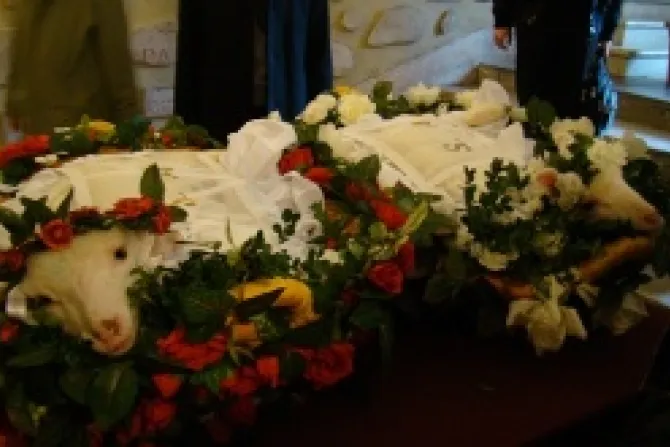Vatican City, Jan 22, 2014 / 03:58 am
Shortly before the blessing of the lambs yesterday in honor of the feast of St. Agnes, the parish priest of the basilica honoring the martyr explained that the tradition has been around since the 16th century.
"Here in (in the basilica of) St. Agnes, we have known this tradition for 500 years," Fr. Franco Bergamin explained to CNA in a Jan. 21 interview shortly before the Mass of the blessing took place.
The priest recalled how the tradition began around the same time that the Regular Lateran Canonichesse were founded, who are a contemplative religious order belonging the Canons Regular of the Lateran Congregation of the Most Holy Saviour, who still serve in the basilica of St. Agnes today.
On Jan. 21 of every year, the feast day of the virgin Agnes who was martyred in the year 304 under the Diocletian persecution, the lambs whose wool will be used weave the pallia of new archbishops are blessed in the Basilica of St. Agnes Outside the Walls in Rome, and then presented to the Pope.
Elaborating on the various symbols of the pallium, a white stole adorned with six black crosses that the Pope and metropolitan archbishops wear in their churches when celebrating the Mass, Fr. Bergamin highlighted that the colors of white and red which are used carry special meaning.
When they are carried into the basilica for the blessing, the lambs are "in two baskets," he noted, explaining that one is "with red flowers and the other one with white flowers in order to indicate the martyrdom and the virginity of Agnes."
The "presence of the lamb" in most depictions of the young martyr has been seen "since the 4th century," the priest continued, adding that as a symbol of her "birth into heaven," every year "a lamb was placed on the tomb of St. Agnes in order to indicate" that that is where she was.
Fr. Bergamin explained that every year the lambs which are chosen for the ceremony are donated by the Tre Fontane abbey in Rome, which is run by the Trappist Fathers of the Cistercian Order, who are cloistered contemplative monastics that follow the Rule of St. Benedict.
After the lambs were blessed, the priest explained that they were delivered to Pope Francis at his residence in the Vatican's Saint Martha guesthouse during 12:30pm appointment.
During the encounter, the Pope would "welcome" the lambs "and deliver them to the sisters of Saint Cecilia in Trastevere," which is a 5th-century church in Rome dedicated to the Saint.
The sisters, explained the priest, "will groom" the lambs "and care for them" until the pallia are to be woven.
Paul Badde contributed to this piece.



